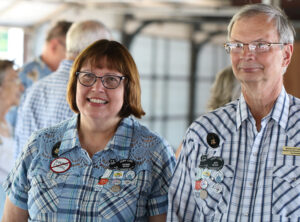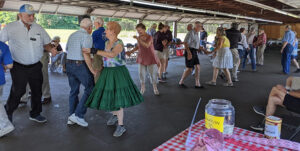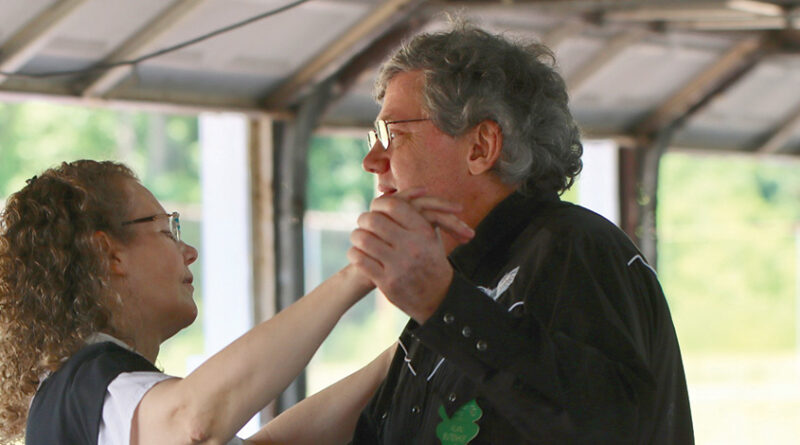Square Dancing is Kicking up its Heels Again
By John Addyman
It was the first thing that struck you. People started arriving just a few minutes before the event started on a Saturday afternoon in July. They were dressed casually and comfortably because of the heat. Ducking into the shade of the pavilion of the party house, they signed in.
And every one of them was smiling. No shy smiles. No perfunctory smiles. No prim polite smiles. But big smiles. Grateful smiles. Ready-to-have-fun smiles.
What was being served here, anyway?
Then the music started. In seconds, the pavilion transformed into a dance hall at 1 p.m. On a day too hot and humid to cut your grass, people were dancing — square dancing.
The Western New York Federation of Square and Round Dancers organized the event at Barnard Restaurant & Party House in Greece.
Co-presidents Debbie and Jeff Blood live right down the road and were playing hosts.
A photographer was trying to get a shot of the two. They smiled and walked away.
“We have to dance,” Debbie explained.
The Bloods have accounting backgrounds. Jeff worked at Park Ridge Hospital for 23 years, and then became a consultant for Coordinated Care Services. Debbie worked in public accounting, then for General Railway Signal, for five years and finally at Wegmans for 34 years — in accounting, management, and as an auditor.
“I loved being an auditor,” she said. “Our last 10 years Jeff and I had great jobs and we could travel together and still work because we could work remotely.”
The Bloods have a son and daughter and five grandchildren. And like thoughtful parents, their house has obvious set-aside areas for their young visiting grandkids.
 “With square dancing, we were both working in accounting when we got married, and we were working more than six days a week in tax season, we’d be working on weekends, but we always saved Tuesday night as date night and we’d go dancing with our friends,” Debbie added.
“With square dancing, we were both working in accounting when we got married, and we were working more than six days a week in tax season, we’d be working on weekends, but we always saved Tuesday night as date night and we’d go dancing with our friends,” Debbie added.
In America, square dancing got its start in the 1700s, died out in the 1800s, and got kick-started again after World War II.
But after the pandemic put a dent in membership and activities, square dancing (where eight people dance together in a “square”) and round dancing (for couples) are just coming back, slowly.
“COVID really hit us hard,” Debbie said. “We lost a lot of people who moved to be with family, with their parents or kids or someone else.”
“We had 20 clubs in the federation back in 2019,” Jeff added.
There are 14 clubs now, with two more expected to become live again this fall. The federation has member clubs from Buffalo to the other side of Syracuse, from the Rochester area south to Bath and Ithaca.
“Square-dancing clubs can range from 15 members to 120, but all those people may not be actively dancing. Copy Cats is the largest club and it originated at Xerox,” Debbie explained.
“Copy Cats has 120 members but they’re down to 70-80 now,” Jeff said. “It’ll come back. Our members are not spring chickens; they’re in their 60s, 70s and 80s. People age out. You simply can’t dance like you used to. Family activities arise that they enjoy as much as dancing, and after COVID, some people just haven’t come back to dancing.”
And that might explain the big smiles on the folks who gathered this hot afternoon. They represented many clubs and they came ready to dance.
Ron Brown has “called” square dancing for decades, providing the directions and pacing for a square dance “tip” that normally lasts about 15 minutes. He points out that dancing is low-impact exercise, a social experience and a mental exercise—the three things that keep all of us moving ahead in life. And yes, square dancing is unabashedly fun.
In an article he wrote on the benefits of square dancing, Brown described how the movement strengthens muscle and bone, exercises the heart and challenges the mind.
“Square dancing provides an opportunity to develop strong social ties, which can contribute to self-esteem and a positive outlook,” he added.
“After COVID, the clubs went back to dancing very gradually,” Debbie said. “We dance in schools, in churches and sometimes in community centers.” And because COVID was an issue that hung in the air, clubs that had live dancing had to comport with the rules of each facility — some rules that are still in practice.
Debbie said the Copy Cats dancers “had to disinfect all the chairs before we left and sanitize the bathrooms.” At a live dance, everyone uses hand sanitizer after each tip.
Many clubs resorted to dancing on Zoom, and some still have that option out of fear of a resurgent COVID.
“You can’t social-distance in square dancing,” Jeff pointed out. “You’re constantly touching hands, shaking hands, and going around in circles. There was a big fear of COVID in square dancing. But, it never happened. We recognized the issue and took extra precautions. We danced whole dances with masks on. If someone told us the next day that a dancer had tested positive, we would follow protocols and skip the next dance.
“There was never an outbreak because we were so precautious,” he stressed.
“Last year, the federation was critical in helping provide the clubs with guidelines to return safely to dancing,” Debbie said.
Two member club presidents worked to establish protocols that were shared with everyone.
Getting started
The Bloods were married in 1978 and each has an accounting background.
“I started with a CPA firm where the husband was a CPA and the wife had her own finance company. Jeff and I were getting married and studying for the CPA exam and all that. They said when things calm down, ‘You’ve got to try square dancing and they wouldn’t leave us alone. I said to Jeff, ‘We’ve got to go square dancing.’ We did, and we fell in love with it. We danced for 15 years, and then with two kids and our jobs, we took a break.
“We got back to it in 2016 at the annual Snowflake Dance with the Copy Cats. We walked in and we knew the caller, Ron Brown. We didn’t dance. We were petrified to dance and we just watched. They said to us after, ‘Why don’t you join our class?’ The class had started in September and we’d be joining it in January, so we joined and graduated with the class in May, and have been dancing ever since.”
You don’t just walk into a square dance and start high-struttin’.
There’s a language to learn and moves to master—about 60 of them—and it takes a while.
If you’re looking to dip your toes into a do-si-do, there are several open houses coming up:
• At the Cloverleaf Squares, First Baptist Church in Chili, Sep. 18 at 5 p.m.
• At the Copy Cats, Scribner Road School in Penfield, Sep. 20 at 7 p.m.
• At the Cayuga Cut-Ups, Weedsport Methodist Church in Weedsport, Oct 2, 9 and 16, 2 p.m.
• At the Batavia Silver Stars, VA Medical Center in Batavia, Sep. 19 at 7 p.m.
• At the Dalton Gang, New Hope Fellowship Church in Castile, Sep. 27 at 6:30 p.m.
 Program for Seniors who want to learn square dancing at the Happy Squares, Spiegel Community Center, Pittsford, Friday afternoons at 2 p.m.
Program for Seniors who want to learn square dancing at the Happy Squares, Spiegel Community Center, Pittsford, Friday afternoons at 2 p.m.
“We invite people to come in and try square dancing,” Debbie said. “And you will be dancing before you leave that night. It will be basic calls. And if you ever want to try it, it’s a lot of fun.”
If you have fun at an open house, which is pretty much a foregone conclusion, it’s time to sign up for lessons. You have to know what you’re doing at a square dance. Otherwise, collisions and lost partners will ensue. Lessons start at a local club in the fall and finish in the spring. Meanwhile, you’re dancing a little more each time.
As a graduate with new-found square-dancing skills, you can go just about anywhere they’re taking allemande lefts. The Bloods dropped in on a square dance on a trip to Arizona and were welcomed there.
Jeff explained that you won’t have trouble understanding the caller even if you’re out of the country and run into a square dance.
“Square dancing is worldwide. The calls are always in English. They decided many years ago to do it in English all over the world,” he said. “So, no matter where you are in the world, you hear the same calls, because it isn’t language-driven. One time we were dancing at this one club and the people were from Germany. Wonderful dancers. Afterwards we couldn’t understand a word they said because they were German, but they were wonderful dancers because they followed the words.”
“People who travel the country can log onto the website, wheresthedance.com, and find thousands of dances locally and around the world. It will tell you square dances within 20 miles of where you are and you can dance where you want to dance,” he added.
More than fun
We all face stresses in our lives. Square dancing is a means to getting away from it all.
Jeff explained how that works: “When Debbie and I are dancing, we know that we’re not going to be talking about work; you focus on the dancing and enjoying the camaraderie of the people you’re with and at the end of the evening you say to yourself, ‘We just had a whole evening of no issue from work or complaining about this or that.’ 44 years married and I tell Debbie I love her more today than I did yesterday.”
“At a national convention, you might be dancing in a room with 50 people, but you wouldn’t know they weren’t members of your own club because they’re just so friendly. It’s just amazing,” he said. I’m usually a kind of quiet person, but in square dancing you get to know everyone. When you graduate from a class in square dancing, you have 30 or 40 new friends. And friends are not easy to come by. You just have this wonderful relationship with people. It’s just a wonderful social atmosphere.”
You can do a lot of research on square (and round) dancing by checking out the federation’s Facebook page, “Square Dancing Rochester” or by going on the website www.squaredancingrochester.org where you’ll find a listing of all the clubs in the federation, schedules and locations of dances, a newsletter, even video dance lessons. If you’re interested in learning a lot more before you go to your first dance, you can spend hours on that website.
Debbie urges people to come out to dance, especially women.
“Right now, we’re short on women in square dancing,” she said. “In the last three months, Jeff has sat out as I danced with other men because we want them to dance.”
There’s no dress requirement. People can wear jeans and polo shirts and shorts—anything.
“We enjoy this so much,” Debbie said. “It’s something you wish more people would try.”

